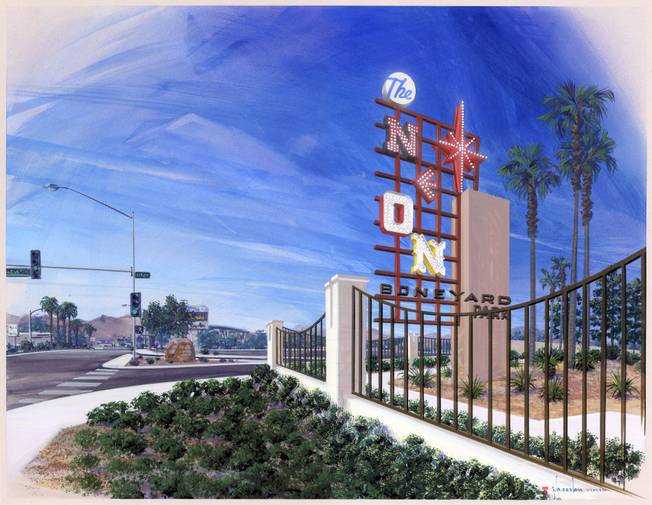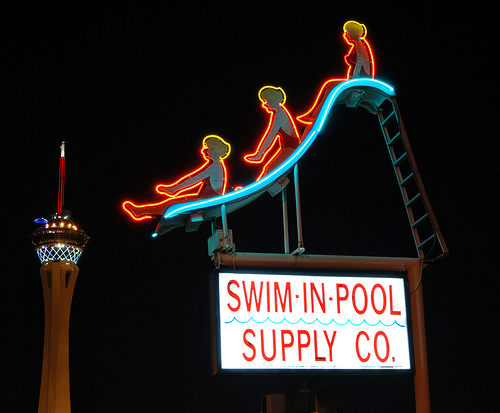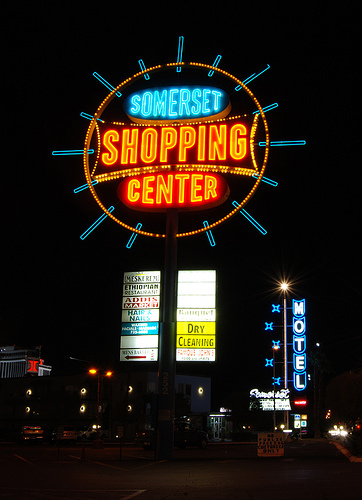As readers here know, Alan Hess is the go-to guy for Mid-Century Modern architecture and the automobile culture that surrounded it. He was one of the guests at our Salute to Walter Zick last fall. In addition to being the go-to guy, he is an author of a variety of work on the various aspects of the era. From "Googie" his look at the coffee shop and diners to "Palm Springs Weekend" celebrating the joys of that Mid-Mod mecca to "The Ranch House". But for Las Vegas Mid-Mod fans, we all love "Viva Las Vegas: After Hours Architecture". If you haven't read this book yet, get thee to the library or better yet, his website.
I talked with Alan a few days ago about Mid-Mod and Las Vegas:
What is mid-century modern architecture and why is it important? After World War II, America found itself on the threshold of a promising future. After the Great Depression, people finally had money and jobs. New technologies offered amazing possibilities: television, automatic transmissions, washing machines in your home – all brought a new, easier way of life. Mid-century Modern architecture mirrored those changes. It created new shapes and used new materials (such as steel, glass, plastic, and concrete) to give people a sense that they were living in a new era. What is roadside architecture? Why was neon so important to Fremont Street and the Strip? The automobile made the twentieth century unique. Cities grew in size because of it. People suddenly had great personal mobility. And the American city took on a new shape in response to these changes. A key element of these changes was a new kind of architecture suited to the car. Drive-in markets, drive-in movies, drive-in restaurants, drive-in banks, gas stations, car washes, and many other types of buildings along the roadside served the way people were living now that they had cars. A big part of this architecture was signage, and neon (a new technology in the 1920s) proved ideal in creating large, vivid signs that could be seen from blocks away. Beginning in the 1930s, Fremont St. became one of the most innovators for neon signs, and neon urbanism, in the nation. This exploration continued on the Strip in the 1950s. Which classic Las Vegas neon sign do you miss the most? Favorite classic Las Vegas casino/hotel? The pinnacle of Las Vegas neon was reached in the 1960s. Those signs are mostly gone now, but they remain one of the highpoints of American art. The Dunes, the Aladdin, the Stardust, the Frontier, the Riviera, the Sahara were all great. The Stardust was one of my favorites, with a scintillating cloud of light, as if falling from the heavens. The Aladdin was a true and original phantasmagoria, evoking veils, jewels, and a Thousand and One Nights. I have the fondest memories of the Dunes because of the shear power of its animation, shooting light into the night sky like a rocket, but completely silently. You did a lot of research for your book, "Viva Las Vegas: After-Hours Architecture." What was some of the information that surprised you? Will there be an updated version of the book? Most of the information in the book was a surprise to me. I had questions about who had designed these hotels and signs since reading Learning From Las Vegas by Venturi, Scott Brown and Izenour in 1975. Who had designed these buildings? Which came first? How did they evolve, and influence each other? Where did they come from? The most illuminating fact was that most of the original architects, who set the standards and models, were from Los Angeles, and had honed their startlingly new conception of auto Modernism while designing the drive-ins and Googie coffee shops there. I would like to do an update of Viva Las Vegas, which was published in 1993, but have no current plans. What was it about Las Vegas that brought so many well-known architects like Welton Becket, Paul R. Williams, Wayne McAllister and many others to Las Vegas to design buildings and hotels? As Venturi, Scott Brown and Izenour said, Los Angeles was the Rome, and Las Vegas was the Florence of this type of Modern architecture. There were strong economic and personal links between the two cities that made it natural for those LA architects to work in Las Vegas. What can we learn from the mid-century modern and roadside architecture of classic Las Vegas? The innovations of this Modern architecture are still refreshing. Especially in a new city like Las Vegas, the traditions of the past held no power. The architectural problems could be solved directly and imaginatively, and the budgets and recreational purposes of the architecture allowed experimentation. These days, the pendulum reacting against car-oriented architecture has swung too far. It needs to swing back a ways, and the purposefulness and creativity of these buildings help show the strengths in this kind of architecture. What do you think of CityCenter and the modern Las Vegas Strip? Will City Center be the direction of the future for Las Vegas?










